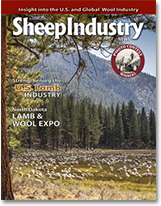Worker Agreements Needed for H-2A Shearers
By AMY TRINIDAD
Sheep Industry News Editor
(Oct. 1, 2013) The H-2A program is utilized to find sheepherders for a number of the larger sheep operations in the West; however, did you also know that sheep shearers and wool handlers are brought into the United States under this program as well?
One challenge of bringing shearers and wool handlers into the country with the H-2A program is the process of developing an itinerary and worker agreement explains Kelli Griffith, executive director of Mountain Plains Agricultural Service (MPAS). MPAS is an agent association that specializes in assisting ranchers with open range livestock herder labor needs through the H-2A program.
This program, which is regulated through the Department of Labor (DOL), Department of Homeland Security and the state department, requires paperwork that explains where an H-2A worker will be and when. To ensure a legal shearing crew, this paperwork needs to be processed through the necessary government channels both here in the United States and the country where the crew member is coming from. Therefore, the itinerary and worker agreement must be completed at least four months prior to shearing.
“Logistically I realize this is tough for producers,” says Griffith. “For example, in November we are working on a certification for a guy that might be shearing in February. This is a long way out to project, but it is something that is required in order to have a legal H-2A shearing crew.”
She relays the worker agreements are the shearing contractor’s biggest challenge to get producers to sign as they are hesitant to commit to a contractor so far in advance. Shearing schedules are very dependent upon Mother Nature. One delay in the crew’s itinerary can cause a ripple effect for those that follow. However, this aspect is not forgotten in the worker agreement.
“The worker agreement still exists if a crew is delayed,” says Griffith, who explains the date on a worker agreement is more of a goal. Producers do not have to agree to specifics just that they are willing to provide work to the contractor and crew. “It’s just a general agreement but it does have to be presented in writing to the DOL.”
Terri Fairchild with Fairchild Shearing has been utilizing the H-2A program since 1987 to bring in shearing crews. She echoes Griffith’s message in that it is imperative for producers to complete the required worker agreement in a timely number.
“We have had wool growers that didn’t get back to me right away with a signed contract,” says Fairchild, “so I had to drop them from my itinerary. They just didn’t realize the importance of it.”
Fairchild explains that she adds to the itinerary that specific dates may vary according to weather and the arrival of the shearing crew. “What we have verbally told our wool growers is that the worker agreement is not a binding contract in our eyes. They know this is a requirement of the DOL. Even though they sign the agreement, they can choose to go with another crew if we are held up.”
Both Griffith and Fairchild agree that the process of bringing an H-2A shearing and wool handling crew into the United States is lengthy and if producers don’t sign the worker agreement and the government agency don’t process the paperwork in a timely manner, everything is thrown off.
“At the end of the day, there aren’t enough American shearers so I’m thankful that we have this process,” says Fairchild about the H-2A program.
Another point Griffith would like to bring to the attention of wool producers is that of the wage setting process for shearers. The mechanism for setting shearer wages is a survey that may inadvertently be distributed to wool producers; however, when wool producers complete the survey, Griffith says they tend to fill them out according to what they pay a shearing contractor. This inaccurate information skews the wages that are actually paid to the shearer.
“It is important that if those surveys are received by wool producers that they contact either the state workforce, the shearer union or even Mountain Plains as we would assist with the surveys. It is just to make sure the data reported is accurate,” she explains.
“The H-2A program as a whole does continue to be challenging; however, it’s a program that works for us as a way of providing a legal workforce,” says Griffith. “It is important that everyone knows it’s not a perfect program, therefore we continue to try to navigate it and follow the rules.”
Visit www.mpaswy.com for more information about the H-2A program. For specific questions regarding the paperwork necessary to hire an H-2A shearing crew, contact Griffith at 307-472-2105 or [email protected] .


